The projects below are the most significant solar cooking projects worldwide. These projects were selected either because they impact a significant number of people, show new strategies for solar cooking promotion, or demonstrate new ways solar cooking is being used for income generation. They illustrate how solar cooking helps in achieving the eight United Nations Millennium Development Goals.
Africa
300px|right
- The Solar Cooker Project helps to improve the lives of Darfur refugees living in Chad - More than 50,000 people in four Darfur refugee camps in Eastern Chad are using locally made solar CooKits designed by Solar Cookers International. The project, which began in 2006, is run by Tchad Solaire and by the British NGO CORD. It is funded by Jewish World Watch and the Kozon Foundation. The project has improved the safety and survival of the women in the refugee camps. Previously, they were faced with dangerous and arduous trips outside the camps to collect scarce firewood. Two of the most extensive projects are at the Touloum Refugee Camp and the Iridimi Refugee Camp.

With assistance from the Swiss ADES Foundation, women receive locally made solar box cookers
.
- Long term investment in Madagascar has created a thriving solar cooking enterprise- The team of the Swiss ADES Foundation (ADES) started its solar cooking program in Madagascar in 2001. By 2012, they have taught the people of Madagascar to build and use more than 50,000 solar cookers, reducing local wood consumption by 65%. Read more detail about ADES' program.
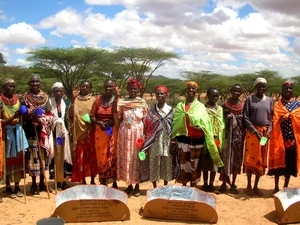
New SHEP workshop participants and trainers
- Solar cooking "Avon Ladies" in Zambia - The Solar Health and Education Project (SHEP) began in 2007 to fund solar cooking workshops in rural areas of Zambia. The team, with direction from Alison Curtis, developed a system to appoint a local leader at the workshop to follow-up with a group of participants to help and encourage using the new cookers. As of 2012, the solar team has ten excellent leaders who take turns spreading the solar news by setting up at shows, events, museum gatherings, school playgrounds, and clinics. Read more about SHEP leadership training.
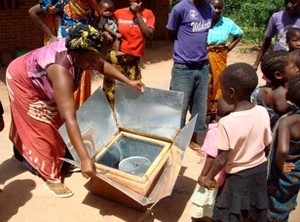
Solar Circle public service exchange program in Tanzania
.
- Solar Circle uses barter system to distribute 3000 solar cookers in Tanzania - The NGO Solar Circle has learned from their solar cooking program in Masasi, southern Tanzania that people will work hard to earn a solar cooker. The group has created a bartering system with community leaders. The community chooses a service project and the beneficiaries organize and oversee the effort. Participants earn an solar oven for their involvement. As of early 2013, the program has distributed more than 3000 solar ovens, and built 40 houses for people who are sick, elderly, widowed, or disabled. Read more about how the barter system is organized.
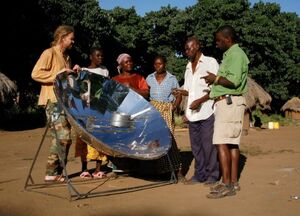
Crosby Menzies demonstrates a parabolic solar cooker at a SunFire Solutions' project in southern Africa.
- Johannesburg-based NGO has aggressively promoted integrated cooking in South Africa and Somalia - SunFire Solutions, based in South Africa, has done more with its publicity campaign since 2003 than any other solar cooking NGO to raise the profile of integrated cooking by introducing solar cookers, retained heat cookers and fuel-efficient woodstoves across southern Africa. Read more about their projects.
Asia
right|300px
- Institutional solar cooking is gaining momentum in India - Completed in 2010, the world’s largest solar cooking system, designed by Gadhia Solar Energy Systems Pvt. Ltd., is functioning at the Shirdi temple, where a solar cooked lunch is served to over 50,000 people per day. The solar steam cooking system is comprised of seventy-three rooftop-mounted Scheffler reflectors of sixteen square meters each. The dishes concentrate sunlight on receivers that contain water, generating steam that is piped down to the kitchen for cooking purposes. Read more about the Shirdi project.
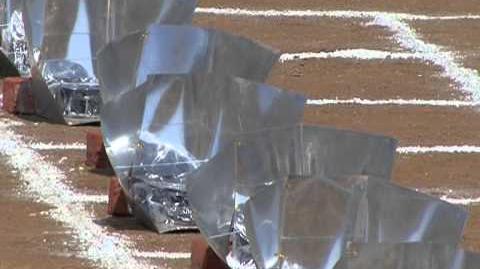
Worlds Largest Solar Cooking Class
2,044 middle school students learn to prepare lunch with solar cooking.
- Indian government makes major investment to teach solar cooking in schools - Ajay Chandak reports that included in the Indian government's five-year plan for 2012 through 2016, 30,000 million INR (approx. $600,000,000USD) is budgeted for solar cooking instruction in 500,000 schools. This will not only help in saving the environment, but it will expose millions and millions of school children to solar cooking and build the confidence that these systems work. Read more about the event...

Residents in northwestern China using their parabolic solar cooker.
- Large-scale use of solar cookers in northwestern China shows promise - Solar Household Energy has tracked the Chinese government's efforts to reduce carbon emissions in the region, because in rural China the predominant fuel for cooking and heating is usually coal. The government has recently utilized the carbon credit trading program of the Clean Development Mechanism. The results proved to support a profitable business model when evaluated in 2013. Since then, it is estimated over two million people have been benefiting from receiving and using 500,000 parabolic solar cookers. CDM project specifics.
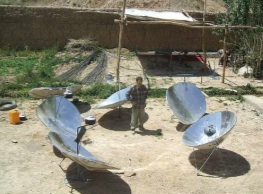
Parabolic solar cookers provided in Indonesia through a Clean Development Mechanism project.
- 30,000 parabolic solar cookers distributed in Indonesia to reduce kerosene consumption - Jakarta Indonesia officials began in 2007 to reduce kerosene consumption with the solar cookers as part of a Clean Development Mechanism project, with help from the German company EnerXi GMbh. Jakarta consumes about 2.7 million liters of kerosene a day. A family using one liter of kerosene per day emits two tons of carbon dioxide (CO2) each year. Through CDM projects, developing countries can earn Certified Emission Reductions (CERs) based on the resulting amount of CO2 reduction. Read more about the kerosene reduction project.
Latin America
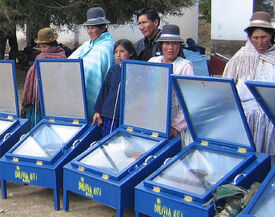
Local villagers in Bolivia proudly display their recently completed solar box cookers using their new carpentry skills.
- Bolivia and Peru have benefitted from successful solar cooking programs - The French NGO, Bolivia Inti-Sud Soleil and Bolivian NGO CEDESOL (working with Bolivian company Sobre la Roca, which produces solar cookers and high efficiency biomass stoves) have together trained thousands of Bolivians and Peruvians to build and use sturdy solar box cookers and fuel-efficient woodstoves. Bolivia Inti-Sud reported in 2011 that they have distributed more than 20,000 ecological appliances since 2000. See Bolivia Inti-Sud Soleil projects
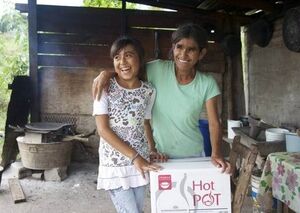
Workshop participants receive their HotPot solar cooker in Mexico.
- The HotPot solar cooker introduction in Mexico - Solar Household Energy (SHE), spent several years developing a solar panel cooker called the HotPot, a variation on Solar Cookers International's cooker, the CooKit. In 2003 SHE received a grant from the World Bank’s Development Marketplace to mount a HotPot promotion project in Mexico working with the Mexican nature conservancy, Fondo Mexicano para la Conservacion de la Naturaleza (FMCN). By July 2004, 2,000 HotPots had been manufactured and trucked to eight local conservation NGOs that had agreed to participate in the HotPot distribution initiative. Solar Household Energy may be the global leader in promoting solar cooking. The history of the HotPot project.

We are World Central Kitchen
José Andrés explains the approach of the World Central Kitchen
- The World Central Kitchen has taken a comprehensive approach to helping the citizens of Haiti - The World Central Kitchen, founded by internationally known chef José Andrés in 2010, has proposed and been implementing a sustainable solution to food shortages in Haiti. Their mission is to promote local food production and purchasing, educating the public about solar cooking and the integrated cooking method, and using these new skills to create opportunities for local income generation. Learn more about the World Central Kitchen.
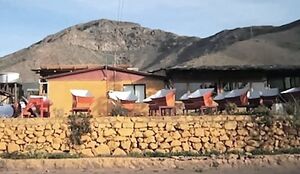
The Delicias del Sol restaurant in Villaseca, Chile
- Solar restaurant in Chile has produced profits - The Delicias del Sol restaurant, known for serving excellent food, has become a tourist destination for the village of Villaseca, Chile. Begun in 2000 with an initial seating capacity of sixteen, the solar restaurant has been able to seat 120 since 2013. The dry central valley area receives over 300 days of sunshine a year, and like similar areas, traditional fuel sources are becoming ever more scarce and expensive. The tourists enjoy viewing the solar kitchen at work. Visit the Delicias del Sol restaurant.
